
Vitaliano Poselli (1840-1918) was an Italian architect from Sicily, mostly known for his work in the city of Thessaloniki, in northern Greece.

Vitaliano Poselli (1840-1918) was an Italian architect from Sicily, mostly known for his work in the city of Thessaloniki, in northern Greece.
He was born in Castiglione di Sicilia in 1838, and studied in Rome. In 1867, the Catholic Church commissioned to him the construction of the Church of Santo Stefano in Istanbul. [1]
From there, the Ottoman government sent him to Thessaloniki (then known as Selânik), where he built some of the most important public edifices of the city. In 1888 he was married and established his residence there. The foreign missions and representatives, such as wealthy merchants of the city, assigned him also the creation of various communal, merchant or private buildings. [2]

Some of his most known works are the Idadiè Imperial College, today's Philosophy Faculty of the Aristotle University (1888), the Government House (Konak) (1891), the Imperial Army Headquarters, today the Greek III Army Corps Headquarters, the New Mosque (1902), the Allatini Mills, the Karipeion Melathron, the State Conservatory building (former Ottoman Bank), the Stoa Malakopi (formerly Banque de Salonique), the Bank of Athens building (today the Jewish Museum of Thessaloniki), Villa Allatini (for the Allatini family, today housing the prefecture), Villa Morpurgo/Zardinidi, the Catholic church of the Immaculate Conception (1897), the Armenian church (1903) and the Catholic churches, and the synagogue of Bet Saul (1898, destroyed 1943). [2]
He had six sons (Primo, Secondo -a musician-, Terzo (a volunteer who served in France against Germany and died in a motorcycle accident on a bridge, his name is written on a grave, in the French cemetery in Thessaloniki, that reminds the Greeks from Thessaloniki who died for the France in the First World War), Quarto, Quinto and Sesto or Emilio) and two daughters. Singer Luisa Poselli was his relative. He had also a younger brother, Salvatore, who designed also some buildings in Thessaloniki.
He died in 1918 and is buried in the Catholic cemetery of St Vincent in Thessaloniki. Many of his descendants still live in the city.
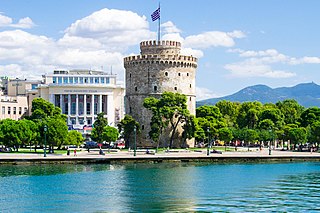
Thessaloniki, also known as Thessalonica, Saloniki, Salonika, or Salonica, is the second-largest city in Greece, with slightly over one million inhabitants in its metropolitan area, and the capital of the geographic region of Macedonia, the administrative region of Central Macedonia and the Decentralized Administration of Macedonia and Thrace. It is also known in Greek as "η Συμπρωτεύουσα", literally "the co-capital", a reference to its historical status as the Συμβασιλεύουσα or "co-reigning" city of the Byzantine Empire alongside Constantinople.
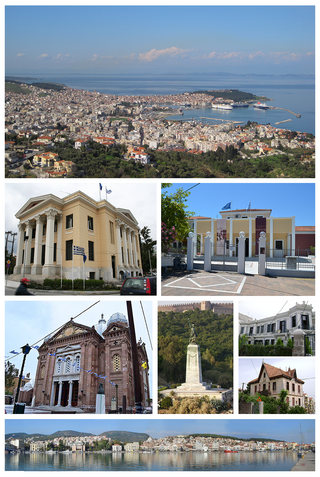
Mytilene is the capital of the Greek island of Lesbos, and its port. It is also the capital and administrative center of the North Aegean Region, and hosts the headquarters of the University of the Aegean. It was founded in the 11th century BC.
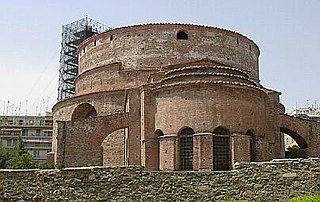
The Arch of Galerius or Kamara (Καμάρα) and the Rotunda (Ροτόντα) are neighbouring early 4th-century AD monuments in the city of Thessaloniki, in the region of Central Macedonia in northern Greece. As an outstanding example of early Byzantine art and architecture, in addition to the importance of the Rotunda as one of the earliest Christian monuments in the Eastern Roman Empire, both sites were inscribed on the UNESCO World Heritage List in 1988 as part of the Paleochristian and Byzantine monuments of Thessaloniki.

Ernst Moritz Theodor Ziller was a German-born university teacher and architect who later became a Greek national. In the late 19th and early 20th centuries, he was a major designer of royal and municipal buildings in Athens, Patras, and other Greek cities.

The Catholic Church in Greece is part of the worldwide Catholic Church, under the spiritual leadership of the Pope in Rome. Indigenous Roman Catholic Greeks numbered about 50,000-70,000 in 2022 and were a religious and not an ethnic minority. Most of them are a remnant of Venetian and Genoese rule in southern Greece and many Greek islands from the early 13th until the late 18th century, Greeks who converted to Catholicism or descendants of the thousands of Bavarians that came to Greece in the 1830s as soldiers and civil administrators, accompanying King Otto. One very old but still common term to reference to them is Φράγκοι, or "Franks", dating to the times of the Byzantine Empire, when medieval Greeks would use that term to describe all Catholics.

Yeşilköy is an affluent neighbourhood in the municipality and district of Bakırköy, Istanbul Province, Turkey. Its population is 25,039 (2022). on the Marmara Sea about 11 kilometres (7 mi) west of Istanbul's historic city centre. Prior to the rapid increase of Istanbul's population in the 1970s, Yeşilköy was a secluded village and sea resort.
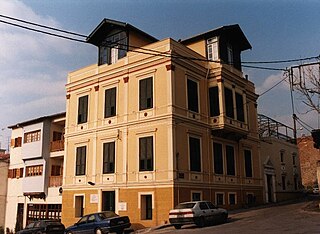
Karipeio Melathro is an Ottoman-period historical building in the center of Thessaloniki, Greece. It is located in the crossroad of Olympiados and Stefaniou Dragoumi streets.

The history of the city of Thessaloniki dates back to the ancient Macedonians. Today with the opening of borders in Southeastern Europe it is currently experiencing a strong revival, serving as the prime port for the northern Greek regions of Macedonia and Thrace, as well as for the whole of Southeastern Europe.

The history of the Jews of Thessaloniki reaches back two thousand years. The city of Thessaloniki housed a major Jewish community, mostly Eastern Sephardim, until the middle of the Second World War. Sephardic Jews immigrated to the city following the expulsion of Jews from Spain by Catholic rulers under the Alhambra Decree of 1492. It is the only known example of a city of this size in the Jewish diaspora that retained a Jewish majority for centuries. This community influenced the Sephardic world both culturally and economically, and the city was nicknamed la madre de Israel.

The Jewish Museum of Thessaloniki is a museum in Thessaloniki, Central Macedonia, Greece. It displays the history of Sephardic Jews and Jewish life in Thessaloniki. The museum is being run by the Jewish community of the city.

The War Museum of Thessaloniki is a military museum in Thessaloniki, Central Macedonia, Greece.

Ioannis Papafis or Giovanni di Niccolò Pappaffy was a Greek businessman and philanthropist, prominent for helping in the funding of the Greek War of Independence and in financing crucial sectors of independent Greece after its successful conclusion. He is considered a national benefactor of Greece. He was among the primary shareholders of the National Bank of Greece, donated to the University of Athens, and the Greek Orthodox Church through the Ecumenical Patriarch of Constantinople.
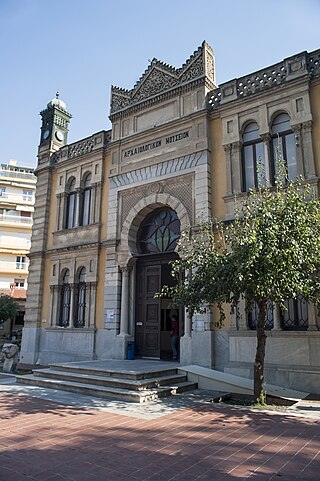
The Yeni Mosque is a historical mosque in Thessaloniki, Greece. It was built by Italian architect Vitaliano Poselli in 1902 for the city's Dönmeh community, crypto-Jewish converts to Islam. However, when the Donmeh left the city during the population exchange between Greece and Turkey, it was used to house the Archaeological Museum of Thessaloniki in 1925. Today, it serves as an exhibition center.

The Konak is an Ottoman-era building in central Thessaloniki, Greece. Originally built in 1891 as the residence (konak) of the governor-general (vali) of the Salonica Vilayet and the seat of the Ottoman authorities, it now houses the Ministry of Macedonia and Thrace.

Thessaloniki's Upper Town called Ano Poli is the old town of Thessaloniki and is located around the city's acropolis north of the city center. The neighborhood is known for its well preserved Byzantine and Ottoman era structures and urban design and as a center for Thessaloniki's poets, intellectuals, and bohemians.

The Allatini Mills is a large former industrial area in the city of Thessaloniki, Greece near Kalamaria district. The name comes from the famous Allatini flourmills founded by the Allatini family in the late 19th century.

Villa Allatini is a three-storey baroque building on Vasilissis Olgas Avenue in the area of Depot in the east of the Municipality of Thessaloniki, Greece. It was constructed in 1898 when Thessaloniki was part of the Ottoman Empire.

The Immaculate Conception Cathedral is a Roman Catholic church located on Frangon street in the city of Thessaloniki, in northern Greece. The church follows the Roman or Latin rite and functions as the seat of the Apostolic Vicariate of Thessaloniki.
Pietro Arrigoni was an Italian architect from Milan, mostly known for his work in the city of Thessaloniki in northern Greece.
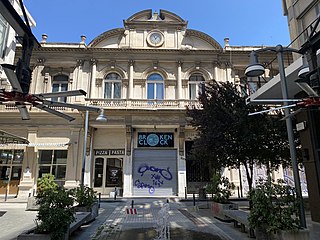
The Bank of Salonica was a regional bank headquartered in Thessaloniki and Istanbul. Created in 1886 under the initial leadership of the Salonica Jewish Allatini family with Austrian, Hungarian and French banking partners, it contributed to the development of the Eastern Mediterranean and Southern Balkans during the late Ottoman Empire. In the Interwar period its activity was mainly focused on Northern Greece, where it operated until the German occupation, and Turkey, where it kept operating until 2001, albeit under different names after 1969. Its preserved headquarters buildings are landmarks, respectively, of Valaoritou Street, a significant thoroughfare of downtown Thessaloniki, and of Bankalar Caddesi in the Karaköy neighborhood of Istanbul.